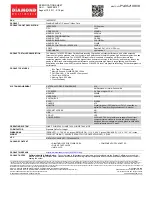
Chapter 2
Hardware Overview
2-4
ni.com
High-Speed Timing
Built from high-speed counters, the high-speed timing circuitry on the
NI 1428 can generate precise real-time control signals for your camera.
Map the output of this circuitry to a trigger line to provide accurate pulses
and pulse trains. Use these control signals to control exposure time and
frame rate.
Note
For your convenience, the external control for cameras that support the NI 1428 has
been preprogrammed into the camera file. You can use MAX to specify the frequency and
duration of these signals in easy-to-use units.
Acquisition and Region of Interest (ROI)
The acquisition and ROI circuitry monitors incoming video signals and
routes the active pixels to the multiple-tap data formatter and SDRAM.
The NI 1428 can perform ROI on all video lines and frames. In an ROI
acquisition, select an area within the acquisition window to transfer across
the PCI bus to system memory.
Note
You can use MAX to set the acquisition and ROI parameters.
Scatter-Gather DMA Controllers
The NI 1428 uses three independent onboard direct memory access (DMA)
controllers. The DMA controllers transfer data between the onboard
SDRAM memory buffers and the PCI bus. Each of these controllers
supports scatter-gather DMA, which allows the DMA controller to
reconfigure on-the-fly. The NI 1428 can perform continuous image
transfers directly to either contiguous or fragmented memory buffers.
Bus Master PCI Interface
The NI 1428 implements the PCI interface with a National Instruments
custom application-specific integrated circuit (ASIC), the PCI MITE.
The PCI interface can transfer data at a theoretical maximum rate of
133 MB/s in bus master mode.
Start Conditions
The NI 1428 can start acquisitions in the following ways:
•
Software control
—The NI 1428 supports software control of
acquisition start. You can configure the NI 1428 to capture a fixed
number of frames. This configuration is useful for capturing a single
frame or a sequence of frames.
















































